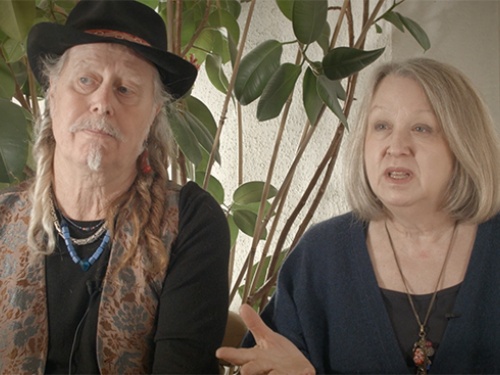Pioneering Media Art: An Interview with Kathy Rae Huffman
Ahead of our Friday Salon Machine Divas: The Archive, exploring early feminist media art practices, Dimitra Gkitska spoke to Kathy Rae Huffman for the ICA Bulletin. A curator, writer and networker, with a special focus on issues concerning the history and development of media art, Huffman has been active in the field of media art since the early 1980s.
DG: Tell us about your first involvement with media art. How does it relate to your curatorial practice?
KRH: My curatorial practice developed in the late 1970s from my—let’s call it obsession—with video art. It started while I was a graduate student at California State University, Long Beach. My part-time job at the Long Beach Public Library—one of the first institutions to feature video art—had video equipment that I, as the staff artist, was assigned to take care of, though I didn’t know anything about it. I learnt how to operate the Sony Portapak and was convinced from the beginning that video was a great creative tool. Once I found out about all the artistic activity that was taking place, mainly in New York, I knew I wanted to work with an artist.
So, to learn more about video as an attribute to exhibition practice and as artistic practice, I joined the Museum and Gallery Studies programme. This was an intensive two-year programme designed by Constance Glenn, that gave grad students the opportunity to work on an exhibition from conception to realization. For this group exhibition, I met Bill Viola at the Long Beach Museum of Art and he agreed to work on an installation for the project. He taught me a lot of what I know about working with artists, what they need from institutions, how to plan a complex technical installation and how to maintain it. From that successful cooperation, I was offered an internship at the Long Beach Museum of Art and it just went on and on from there. No looking back and no regrets.
Your curatorial practice is very hands-on and involves working closely with artists.
From the beginning, I have enjoyed creating opportunities for artists to work, realise new ideas and exhibit and come together with audiences in dialogue about their work. I don’t actually consider this work in itself - it’s just what I do and who I am. Looking back, I see that I was very fortunate to be in the right place at the right time, but I also took the risk of jumping in over my head and became part of a community of artists and curators. We had a very hard struggle getting audiences to understand why, for example, a TV set was in a museum gallery.
How was video art perceived by arts professionals at the time?
The word 'video' was not in common use at the time - neither arts professionals nor people in general knew what the word meant. They did not understand how video could be art. Experimental film was accepted, but also not as art. And, filmmakers and video artists approached the moving image from very different points of view. At that time, the quality of video was considered poor, especially by filmmaking standards. The editing was crude, the image quality was grainy, and the topics often were narcissistic, introspective and in real time. Artists worked with these inherent qualities of video.
The book collection that you recently donated to Goldsmiths library [the Kathy Rae Huffman Media Art Library] includes catalogues and rare documentation of media and video art of the 1980s and 1990s. How do you think these publications stand today, particularly in relation to contemporary practices?
In some ways, the library is a companion to the video collection I amassed, which is currently being preserved at the North West Film Archive in Manchester. These publications and catalogues are examples of what the artistic concerns were at the time and who was in my—quite large—circle of interest. It also represents where I travelled as a curious curator, including the former Yugoslavia, Russia and other central European countries. Significantly, it gives an idea about who was able to publish at that time and some insight into the practice of media art, before internet. Most of these publications are not online; they are limited production, not well distributed. Without seeing these kinds of publications, one is led to believe only what one finds on the internet, which is, of course, not the whole story. Not everything is online! ■
Friday Salon: Machine Divas: The Archive is on 1 May, at 3pm.
This article is posted in: Blog, Events, Interviews, Video
Tagged with: Kathy Rae Huffman, Feminism, Media Art, Video, Machine Divas, learning, interview







